Palladium Nanoparticles Functionalized with PVP-Quercetin Inhibits Cell Proliferation and Activates Apoptosis in Colorectal Cancer Cells
Abstract
1. Introduction
2. Materials and Methods
2.1. Materials and Cells
2.2. Nanoparticles Synthesis
2.3. Nanoparticles Characterization
2.4. Nanoparticles Reactivity Characterization
2.4.1. Dye Degradation
2.4.2. Quercetin Liberation
2.5. Cellular Activity
2.5.1. Cell Proliferation Assays
2.5.2. Apoptosis Assays
2.6. Statistical Analysis
3. Results and Discussion
3.1. Nanoparticles Synthesis
3.2. Nanoparticle Characterization
3.3. Nanoparticles Reactivity Characterization
3.4. Effects of PdNPs-PVP-Q on the Cell Viability and Apoptosis of Cancer Colorectal Cells
4. Conclusions
Author Contributions
Funding
Institutional Review Board Statement
Informed Consent Statement
Data Availability Statement
Acknowledgments
Conflicts of Interest
References
- Roy, S.; Ghosh, C.K.; Chandan, K.S. Nanotechnology; Taylor & Francis: Boca Raton, FL, USA, 2018; ISBN 9781138032736. [Google Scholar]
- Peigneux, A.; Oltolina, F.; Colangelo, D.; Iglesias, G.R.; Delgado, A.V.; Prat, M.; Jimenez-Lopez, C. Functionalized Biomimetic Magnetic Nanoparticles as Effective Nanocarriers for Targeted Chemotherapy. Part. Part. Syst. Charact. 2019, 36, 1–11. [Google Scholar] [CrossRef]
- Abdifetah, O.; Na-Bangchang, K. Pharmacokinetic studies of nanoparticles as a delivery system for conventional drugs and herb-derived compounds for cancer therapy: A systematic review. Int. J. Nanomed. 2019, 14, 5659–5677. [Google Scholar] [CrossRef]
- de Almeida, J.M.F.; Júnior, E.D.; Verríssimo, L.M.; Fernandes, N.S. pH-Dependent release system of isoniazid carried on nanoparticles of silica obtained from expanded perlite. Appl. Surf. Sci. 2019, 489, 297–312. [Google Scholar] [CrossRef]
- Karimi, M.; Eslami, M.; Sahandi-Zangabad, P.; Mirab, F.; Farajisafiloo, N.; Shafaei, Z.; Ghosh, D.; Bozorgomid, M.; Dashkhaneh, F.; Hamblin, M.R. pH-Sensitive stimulus-responsive nanocarriers for targeted delivery of therapeutic agents. Wiley Interdiscip. Rev. Nanomed. Nanobiotechnology 2016, 8, 696–716. [Google Scholar] [CrossRef]
- Rolim, W.R.; Pieretti, J.C.; Renó, D.L.S.; Lima, B.A.; Nascimento, M.H.M.; Ambrosio, F.N.; Lombello, C.B.; Brocchi, M.; De Souza, A.C.S.; Seabra, A.B. Antimicrobial Activity and Cytotoxicity to Tumor Cells of Nitric Oxide Donor and Silver Nanoparticles Containing PVA/PEG Films for Topical Applications. ACS Appl. Mater. Interfaces 2019. [Google Scholar] [CrossRef]
- Ullah, S.; Ahmad, A.; Khan, A.; Zhang, J.; Raza, M.; ur Rahman, A.; Tariq, M.; Ali khan, U.; Zada, S.; Yuan, Q. Palladium nanoparticles synthesis, characterization using glucosamine as the reductant and stabilizing agent to explore their antibacterial & catalytic applications. Microb. Pathog. 2018, 125, 150–157. [Google Scholar] [CrossRef]
- Mahmoodi, S.; Elmi, A.; Hallaj-nezhadi, S. Copper Nanoparticles as Antibacterial Agents. J. Mol. Pharm. Org. Process Res. 2018, 6, 1–7. [Google Scholar] [CrossRef]
- Lorenzen, A.L.; Rossi, T.S.; Riegel-Vidotti, I.C.; Vidotti, M. Influence of cationic and anionic micelles in the (sono) chemical synthesis of stable Ni(OH) 2 nanoparticles: “In situ” zeta-potential measurements and electrochemical properties. Appl. Surf. Sci. 2018, 455, 357–366. [Google Scholar] [CrossRef]
- Ching, Y.C.; Gunathilake, T.M.S.U.; Chuah, C.H.; Ching, K.Y.; Singh, R.; Liou, N.S. Curcumin/Tween 20-incorporated cellulose nanoparticles with enhanced curcumin solubility for nano-drug delivery: Characterization and in vitro evaluation. Cellulose 2019, 26, 5467–5481. [Google Scholar] [CrossRef]
- Yan, B.; Wang, Y.; Ma, Y.; Zhao, J.; Liu, Y.; Wang, L. In vitro and in vivo evaluation of poly (acrylic acid) modified mesoporous silica nanoparticles as pH response carrier for β-elemene self-micro emulsifying. Int. J. Pharm. 2019, 572, 118768. [Google Scholar] [CrossRef]
- Pisárčik, M.; Lukáč, M.; Jampílek, J.; Bilka, F.; Bilková, A.; Pašková, Ľ.; Devínsky, F.; Horáková, R.; Opravil, T. Silver nanoparticles stabilised with cationic single-chain surfactants. Structure-physical properties-biological activity relationship study. J. Mol. Liq. 2018, 272, 60–72. [Google Scholar] [CrossRef]
- Yeap, S.P. Permanent agglomerates in powdered nanoparticles: Formation and future prospects. Powder Technol. 2018, 323, 51–59. [Google Scholar] [CrossRef]
- Ko, Y.; Kim, J.; Lee, K.; Park, J.; Baik, Y.; Choi, H.; Lee, W. ScienceDirect Palladium nanoparticles from surfactant/fast- reduction combination one-pot synthesis for the liquid fuel cell applications. Int. J. Hydrog. Energy 2018, 43, 19029–19037. [Google Scholar] [CrossRef]
- Nguyen, H.T.; Soe, Z.C.; Yang, K.Y.; Phung, C.D.; Nguyen, L.T.T.; Jeong, J.H.; Jin, S.G.; Choi, H.G.; Ku, S.K.; Yong, C.S.; et al. Transferrin-conjugated pH-sensitive platform for effective delivery of porous palladium nanoparticles and paclitaxel in cancer treatment. Colloids Surf. B Biointerfaces 2019, 176, 265–275. [Google Scholar] [CrossRef]
- Phan, T.T.V.; Hoang, G.; Nguyen, V.T.; Nguyen, T.P.; Kim, H.H.; Mondal, S.; Manivasagan, P.; Moorthy, M.S.; Lee, K.D.; Junghwan, O. Chitosan as a stabilizer and size-control agent for synthesis of porous flower-shaped palladium nanoparticles and their applications on photo-based therapies. Carbohydr. Polym. 2019, 205, 340–352. [Google Scholar] [CrossRef]
- Sharmila, G.; Farzana Fathima, M.; Haries, S.; Geetha, S.; Manoj Kumar, N.; Muthukumaran, C. Green synthesis, characterization and antibacterial efficacy of palladium nanoparticles synthesized using Filicium decipiens leaf extract. J. Mol. Struct. 2017, 1138, 35–40. [Google Scholar] [CrossRef]
- Athie-García, M.S.; Piñón-Castillo, H.A.; Muñoz-Castellanos, L.N.; Ulloa-Ogaz, A.L.; Martínez-Varela, P.I.; Quintero-Ramos, A.; Duran, R.; Murillo-Ramirez, J.G.; Orrantia-Borunda, E. Cell wall damage and oxidative stress in Candida albicans ATCC10231 and Aspergillus niger caused by palladium nanoparticles. Toxicol. Vitr. 2018, 48. [Google Scholar] [CrossRef]
- Nisar, P.; Ali, N.; Rahman, L.; Ali, M.; Shinwari, Z.K. Antimicrobial activities of biologically synthesized metal nanoparticles: An insight into the mechanism of action. J. Biol. Inorg. Chem. 2019, 24, 929–941. [Google Scholar] [CrossRef]
- Hamdouche, Y.; Guehi, T.; Durand, N.; Kedjebo, K.B.D.; Montet, D.; Meile, J.C. Dynamics of microbial ecology during cocoa fermentation and drying: Towards the identification of molecular markers. Food Control 2015, 48, 117–122. [Google Scholar] [CrossRef]
- Tahir, K.; Nazir, S.; Li, B.; Ahmad, A.; Nasir, T.; Khan, A.U.; Shah, S.A.A.; Khan, Z.U.H.; Yasin, G.; Hameed, M.U. Sapium sebiferum leaf extract mediated synthesis of palladium nanoparticles and in vitro investigation of their bacterial and photocatalytic activities. J. Photochem. Photobiol. B Biol. 2016, 164, 164–173. [Google Scholar] [CrossRef]
- Ocsoy, I.; Demirbas, A.; McLamore, E.S.; Altinsoy, B.; Ildiz, N.; Baldemir, A. Green synthesis with incorporated hydrothermal approaches for silver nanoparticles formation and enhanced antimicrobial activity against bacterial and fungal pathogens. J. Mol. Liq. 2017, 238, 263–269. [Google Scholar] [CrossRef]
- Ildiz, N.; Baldemir, A.; Altinkaynak, C.; Özdemir, N.; Yilmaz, V.; Ocsoy, I. Self assembled snowball-like hybrid nanostructures comprising Viburnum opulus L. extract and metal ions for antimicrobial and catalytic applications. Enzyme Microb. Technol. 2017, 102, 60–66. [Google Scholar]
- Li, T.; Li, F.; Liu, X.; Liu, J.; Li, D. Synergistic anti-inflammatory effects of quercetin and catechin via inhibiting activation of TLR4–MyD88-mediated NF-κB and MAPK signaling pathways. Phyther. Res. 2019, 33, 756–767. [Google Scholar] [CrossRef]
- Reyes-Farias, M.; Carrasco-Pozo, C. The anti-cancer effect of quercetin: Molecular implications in cancer metabolism. Int. J. Mol. Sci. 2019, 20, 1–19. [Google Scholar] [CrossRef]
- Ezzati, M.; Yousefi, B.; Velaei, K.; Safa, A. A review on anti-cancer properties of Quercetin in breast cancer. Life Sci. 2020, 248. [Google Scholar] [CrossRef]
- Kashyap, D.; Garg, V.K.; Tuli, H.S.; Yerer, M.B.; Sak, K.; Sharma, A.K.; Kumar, M.; Aggarwal, V.; Sandhu, S.S. Fisetin and quercetin: Promising flavonoids with chemopreventive potential. Biomolecules 2019, 9, 174. [Google Scholar]
- Boonlaos, A.; Wechsirisan, W.; Chaibuth, P.; Chupia, V. Comparative Immunology, Microbiology and Infectious Diseases Quercetin enhances and modulates the fungal killing efficacy of chicken heterophils through immunological recognition, effector functions, and resolution. Comp. Immunol. Microbiol. Infect. Dis. 2021, 74, 101582. [Google Scholar] [CrossRef]
- Tang, S.; Deng, X.; Zhou, J.; Li, Q.; Ge, X.; Miao, L. Biomedicine & Pharmacotherapy Pharmacological basis and new insights of quercetin action in respect to its anti-cancer effects. Biomed. Pharmacother. 2020, 121, 109604. [Google Scholar] [CrossRef]
- Liu, Y.; Tang, Z.; Lin, Y.; Qu, X.; Lv, W.; Wang, G.; Li, C. ScienceDirect Effects of quercetin on proliferation and migration of human glioblastoma U251 cells. Biomed. Pharmacother. 2017, 92, 33–38. [Google Scholar] [CrossRef]
- Teekaraman, D.; Elayapillai, S.P.; Viswanathan, M.P.; Jagadeesan, A. Chemico-Biological Interactions Quercetin inhibits human metastatic ovarian cancer cell growth and modulates components of the intrinsic apoptotic pathway in PA-1 cell line. Chem. Biol. Interact. 2019, 300, 91–100. [Google Scholar] [CrossRef]
- Aalinkeel, R.; Bindukumar, B.; Reynolds, J.L.; Sykes, D.E.; Mahajan, S.D.; Chadha, K.C.; Schwartz, S.A. The Dietary Bioflavonoid, Quercetin, Selectively Induces Apoptosis of Prostate Cancer Cells by Down-Regulating the Expression of Heat Shock Protein 90. Prostate 2008, 1789. [Google Scholar] [CrossRef]
- Nguyen, H.T.; Goycoolea, F.M. Chitosan/Cyclodextrin/TPP nanoparticles loaded with quercetin as novel bacterial quorum sensing inhibitors. Molecules 2017, 22, 1–24. [Google Scholar] [CrossRef]
- Liu, H.; Han, Y.; Wang, T.; Zhang, H.; Xu, Q.; Yuan, J.; Li, Z. Targeting Microglia for Therapy of Parkinson’s Disease by Using Biomimetic Ultrasmall Nanoparticles. J. Am. Chem. Soc. 2020, 142, 21730–21742. [Google Scholar] [CrossRef]
- Gurunathan, S.; Jeyaraj, M.; Kang, M.H.; Kim, J.H. Melatonin enhances palladium-nanoparticle-induced cytotoxicity and apoptosis in human lung epithelial adenocarcinoma cells a549 and h1229. Antioxidants 2020, 9, 1–29. [Google Scholar] [CrossRef]
- Fleming, E.; Luo, Y. Co-delivery of synergistic antioxidants from food sources for the prevention of oxidative stress. J. Agric. Food Res. 2021, 3, 100107. [Google Scholar] [CrossRef]
- Balakrishnan, S.; Bhat, F.A.; Raja Singh, P.; Mukherjee, S.; Elumalai, P.; Das, S.; Patra, C.R.; Arunakaran, J. Gold nanoparticle–conjugated quercetin inhibits epithelial–mesenchymal transition, angiogenesis and invasiveness via EGFR/VEGFR-2-mediated pathway in breast cancer. Cell Prolif. 2016, 49, 678–697. [Google Scholar] [CrossRef]
- de Oliveira Pedro, R.; Hoffmann, S.; Pereira, S.; Goycoolea, F.M.; Schmitt, C.C.; Neumann, M.G. Self-assembled amphiphilic chitosan nanoparticles for quercetin delivery to breast cancer cells. Eur. J. Pharm. Biopharm. 2018, 131, 203–210. [Google Scholar] [CrossRef]
- Sun, D.; Li, N.; Zhang, W.; Zhao, Z.; Mou, Z.; Huang, D.; Liu, J.; Wang, W. Design of PLGA-functionalized quercetin nanoparticles for potential use in Alzheimer’s disease. Colloids Surfaces B Biointerfaces 2016, 148, 116–129. [Google Scholar] [CrossRef]
- Creighton, J.A.; Eadon, D.G. Ultraviolet-visible absorption spectra of the colloidal metallic elements. J. Chem. Soc. Faraday Trans. 1991, 87, 3881–3891. [Google Scholar] [CrossRef]
- Li, G.; Li, Y.; Wang, Z.; Liu, H. Green synthesis of palladium nanoparticles with carboxymethyl cellulose for degradation of azo-dyes. Mater. Chem. Phys. 2017, 187, 133–140. [Google Scholar] [CrossRef]
- Xiong, Y.; Huang, L.; Mahmud, S.; Yang, F.; Liu, H. Bio-synthesized palladium nanoparticles using alginate for catalytic degradation of azo-dyes. Chin. J. Chem. Eng. 2020, 28, 1334–1343. [Google Scholar] [CrossRef]
- Nasrollahzadeh, M.; Mohammad Sajadi, S. Pd nanoparticles synthesized in situ with the use of Euphorbia granulate leaf extract: Catalytic properties of the resulting particles. J. Colloid Interface Sci. 2016, 462, 243–251. [Google Scholar] [CrossRef]
- Yang, Y.; Wang, T.; Chen, D.; Ma, Q.; Zheng, Y.; Liao, S.; Wang, Y.; Zhang, J. Quercetin preferentially induces apoptosis in KRAS-mutant colorectal cancer cells via JNK signaling pathways. Cell Biol. Int. 2019, 43, 117–124. [Google Scholar] [CrossRef]
- Walbrück, K.; Kuellmer, F.; Witzleben, S.; Guenther, K. Synthesis and characterization of PVP-stabilized palladium nanoparticles by XRD, SAXS, SP-ICP-MS, and SEM. J. Nanomater. 2019, 2019. [Google Scholar] [CrossRef]
- Çelik, B.; Yildiz, Y.; Sert, H.; Erken, E.; Koşkun, Y.; Şen, F. Monodispersed palladium-cobalt alloy nanoparticles assembled on poly(N-vinyl-pyrrolidone) (PVP) as a highly effective catalyst for dimethylamine borane (DMAB) dehydrocoupling. RSC Adv. 2016, 6, 24097–24102. [Google Scholar] [CrossRef]
- Rashidian Vaziri, M.R.; Omidvar, A.; Jaleh, B.; Partovi Shabestari, N. Investigating the extrinsic size effect of palladium and gold spherical nanoparticles. Opt. Mater. (Amst) 2017, 64, 413–420. [Google Scholar] [CrossRef]
- Wu, Z.; Xiao, D.; Lee, J.; Ren, P.; Song, M.; Li, D. Palladium nanostructures with well-controlled morphologies obtained by one-pot and one-step polyol method. J. Cryst. Growth 2019, 521, 34–40. [Google Scholar] [CrossRef]
- Yang, L.; Cheng, G.; Guo, Y.; Li, D.; Xia, L.; Liu, H. Steam treatment: A facile and effective process for the removal of PVP from shape-controlled palladium nanoparticles. Nanoscale 2018, 10, 11992–11996. [Google Scholar] [CrossRef]
- Ramalingam, V.; Raja, S.; Harshavardhan, M. In situ one-step synthesis of polymer-functionalized palladium nanoparticles: An efficient anticancer agent against breast cancer. Dalt. Trans. 2020, 49, 3510–3518. [Google Scholar] [CrossRef]
- Nasrollahzadeh, M.; Sajadi, S. Green synthesis of copper nanoparticles using Ginkgo biloba L. leaf extract and their catalytic activity for the Huisgen cycloaddition of azides and alkynes at. J. Colloid Interface Sci. 2015, 457, 141–147. [Google Scholar]
- Garai, C.; Hasan, S.N.; Barai, A.C.; Ghorai, S.; Panja, S.K.; Bag, B.G. Green synthesis of Terminalia arjuna-conjugated palladium nanoparticles (TA-PdNPs) and its catalytic applications. J. Nanostructure Chem. 2018, 8, 465–472. [Google Scholar] [CrossRef]
- Le, N.T.T.; Nguyen, D.H.; Nguyen, N.H.; Ching, Y.C.; Nguyen, D.Y.P.; Ngo, C.Q.; Nhat, H.N.T.; Thi, T.T.H. Silver nanoparticles ecofriendly synthesized by achyranthes aspera and scoparia dulcis leaf broth as an effective fungicide. Appl. Sci. 2020, 10, 1–14. [Google Scholar] [CrossRef]
- Givens, B.E.; Wilson, E.; Fiegel, J. The effect of salts in aqueous media on the formation of the BSA corona on SiO 2 nanoparticles. Colloids Surfaces B Biointerfaces 2019, 179, 374–381. [Google Scholar] [CrossRef]
- Iyahraja, S.; Rajadurai, J.S. Stability of Aqueous Nanofluids Containing PVP-Coated Silver Nanoparticles. Arab. J. Sci. Eng. 2016, 41, 653–660. [Google Scholar] [CrossRef]
- Saxena, M.; Tarachand Sathe, V.G.; Okram, G.S. Enhanced zeta potential of polyol method synthesized PVP-capped Sb 2 S 3 nanoparticles. AIP Conf. Proc. 2019, 2100, 2–7. [Google Scholar] [CrossRef]
- Tarachand, Sathe, V.G.; Okram, G.S. G.; Okram, G.S. Zeta potential and Raman studies of PVP capped Bi2S3 nanoparticles synthesized by polyol method. AIP Conf. Proc. 2018, 1953, 3–7. [Google Scholar] [CrossRef]
- Vergara-Castañeda, H.; Hernandez-Martinez, A.R.; Estevez, M.; Mendoza, S.; Luna-Barcenas, G.; Pool, H. Quercetin conjugated silica particles as novel biofunctional hybrid materials for biological applications. J. Colloid Interface Sci. 2016, 466, 44–55. [Google Scholar] [CrossRef]
- Lebaschi, S.; Hekmati, M.; Veisi, H. Green synthesis of palladium nanoparticles mediated by black tea leaves (Camellia sinensis) extract: Catalytic activity in the reduction of 4-nitrophenol and Suzuki-Miyaura coupling reaction under ligand-free conditions. J. Colloid Interface Sci. 2017, 485, 223–231. [Google Scholar] [CrossRef]
- Sunoqrot, S.; Al-Shalabi, E.; Messersmith, P.B. Facile synthesis and surface modification of bioinspired nanoparticles from quercetin for drug delivery. Biomater. Sci. 2018, 6, 2656–2666. [Google Scholar] [CrossRef]
- Larkin, P. IR and Raman Spectroscopy; Elsevier: Amsterdam, The Netherlands, 2011; ISBN 978-0-12-386984-5. [Google Scholar]
- Sadhukhan, P.; Kundu, M.; Chatterjee, S.; Ghosh, N.; Manna, P.; Das, J.; Sil, P.C. Targeted delivery of quercetin via pH-responsive zinc oxide nanoparticles for breast cancer therapy. Mater. Sci. Eng. C 2019, 100, 129–140. [Google Scholar] [CrossRef]
- Seo, M.H.; Choi, S.M.; Lee, D.U.; Kim, W.B.; Chen, Z. Correlation between theoretical descriptor and catalytic oxygen reduction activity of graphene supported palladium and palladium alloy electrocatalysts. J. Power Sources 2015, 300, 1–9. [Google Scholar] [CrossRef]
- Anjum, F.; Khan, M.I.; Khan, M.A. Efficient synthesis of palladium nanoparticles using guar gum as stabilizer their applications as catalyst in reduction reactions and degradation of azo dyes. Green Process Synth 2020, 63–76. [Google Scholar]
- Rigas, F.; Morales, A.A.; Navarrete, M. Assessment of Copper Slag as a Sustainable Fenton-Type Photocatalyst for Water Disinfection. Water Reclam. Sustain. 2014, 199–227. [Google Scholar] [CrossRef]
- Peskova, M.; Ilkovics, L.; Hynek, D.; Dostalova, S.; Sanchez-Carnerero, E.M.; Remes, M.; Heger, Z.; Pekarik, V. Detergent-modified catalytic and enzymomimetic activity of silver and palladium nanoparticles biotemplated by Pyrococcus furiosus ferritin. J. Colloid Interface Sci. 2019, 537, 20–27. [Google Scholar] [CrossRef]
- Pourreza, N.; Abdollahzadeh, R. Colorimetric determination of hydrazine and nitrite using catalytic effect of palladium nanoparticles on the reduction reaction of methylene blue. Microchem. J. 2019, 150, 104067. [Google Scholar] [CrossRef]
- Chatha, S.A.S.; Asgher, M.; Iqbal, H.M.N. Enzyme-based solutions for textile processing and dye contaminant biodegradation—a review. Environ. Sci. Pollut. Res. 2017, 24, 14005–14018. [Google Scholar] [CrossRef]
- Raman, C.D.; Kanmani, S. Decolorization of Mono Azo Dye and Textile Wastewater using Nano Iron Particles. Environ. Prog. Sustain. Energy 2019, 38, S366–S376. [Google Scholar] [CrossRef]
- McNamara, K.; Tofail, S.A.M. Nanosystems: The use of nanoalloys, metallic, bimetallic, and magnetic nanoparticles in biomedical applications. Phys. Chem. Chem. Phys. 2015, 17, 27981–27995. [Google Scholar] [CrossRef]
- Wu, C.Y.; Chen, Y.C. Riboflavin immobilized Fe3O4 magnetic nanoparticles carried with n-butylidenephthalide as targeting-based anticancer agents. Artif. Cells, Nanomedicine Biotechnol. 2019, 47, 210–220. [Google Scholar] [CrossRef]
- Fan, X.; Domszy, R.C.; Hu, N.; Yang, A.J.; Yang, J.; David, A.E. Synthesis of silica–alginate nanoparticles and their potential application as pH-responsive drug carriers. J. Sol-Gel Sci. Technol. 2019, 91, 11–20. [Google Scholar] [CrossRef]
- Akal, Z.U.; Alpsoy, L.; Baykal, A. Superparamagnetic iron oxide conjugated with folic acid and carboxylated quercetin for chemotherapy applications. Ceram. Int. 2016, 42, 9065–9072. [Google Scholar] [CrossRef]
- Baksi, R.; Singh, D.P.; Borse, S.P.; Rana, R.; Sharma, V.; Nivsarkar, M. In vitro and in vivo anticancer efficacy potential of Quercetin loaded polymeric nanoparticles. Biomed. Pharmacother. 2018, 106, 1513–1526. [Google Scholar] [CrossRef]
- Gurunathan, S.; Qasim, M.; Park, C.H.; Iqbal, M.A.; Yoo, H.; Hwang, J.H.; Uhm, S.J.; Song, H.; Park, C.; Choi, Y.; et al. Cytotoxicity and transcriptomic analyses of biogenic palladium nanoparticles in human ovarian cancer cells (Skov3). Nanomaterials 2019, 9. [Google Scholar] [CrossRef]
- Chong, Y.; Dai, X.; Fang, G.; Wu, R.; Zhao, L.; Ma, X.; Tian, X.; Lee, S.; Zhang, C.; Chen, C.; et al. Palladium concave nanocrystals with high-index facets accelerate ascorbate oxidation in cancer treatment. Nat. Commun. 2018, 9, 1–11. [Google Scholar] [CrossRef]
- De Mello Costa, A.R.; Marquiafável, F.S.; De Oliveira Lima Leite Vaz, M.M.; Rocha, B.A.; Pires Bueno, P.C.; Amaral, P.L.M.; Da Silva Barud, H.; Berreta-Silva, A.A. Quercetin-PVP K25 solid dispersions: Preparation, thermal characterization and antioxidant activity. J. Therm. Anal. Calorim. 2011, 104, 273–278. [Google Scholar] [CrossRef]
- Vittorio, O.; Curcio, M.; Cojoc, M.; Goya, G.F.; Hampel, S.; Iemma, F.; Dubrovska, A.; Cirillo, G. Polyphenols delivery by polymeric materials: Challenges in cancer treatment. Drug Deliv. 2017, 24, 162–180. [Google Scholar] [CrossRef]
 quercetin (Q),
quercetin (Q),  polyvinylpyrrolidone (PVP),
polyvinylpyrrolidone (PVP),  Palladium nanoparticles (PdNPs)-PVP-Q.
Palladium nanoparticles (PdNPs)-PVP-Q.
 quercetin (Q),
quercetin (Q),  polyvinylpyrrolidone (PVP),
polyvinylpyrrolidone (PVP),  Palladium nanoparticles (PdNPs)-PVP-Q.
Palladium nanoparticles (PdNPs)-PVP-Q.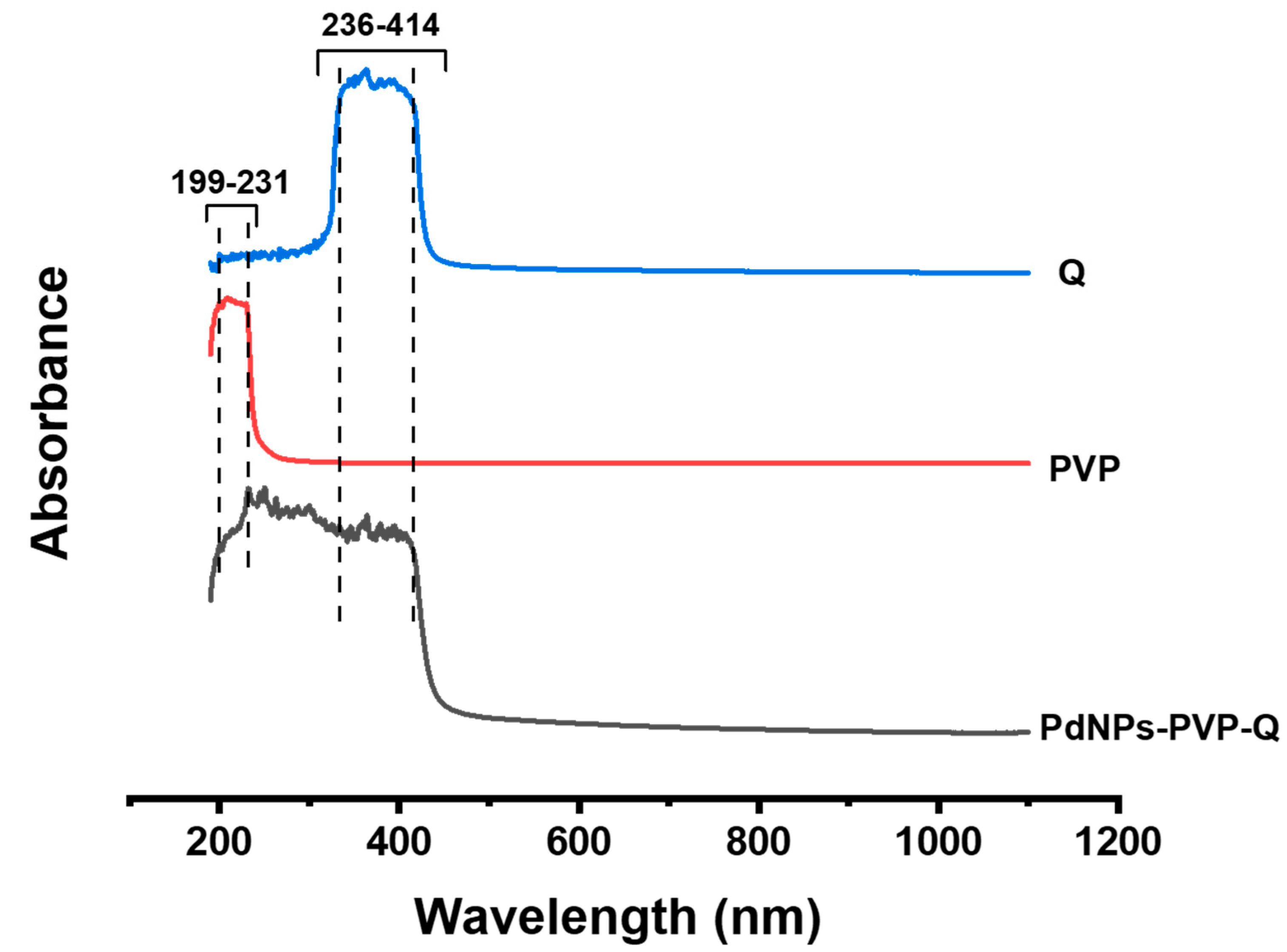

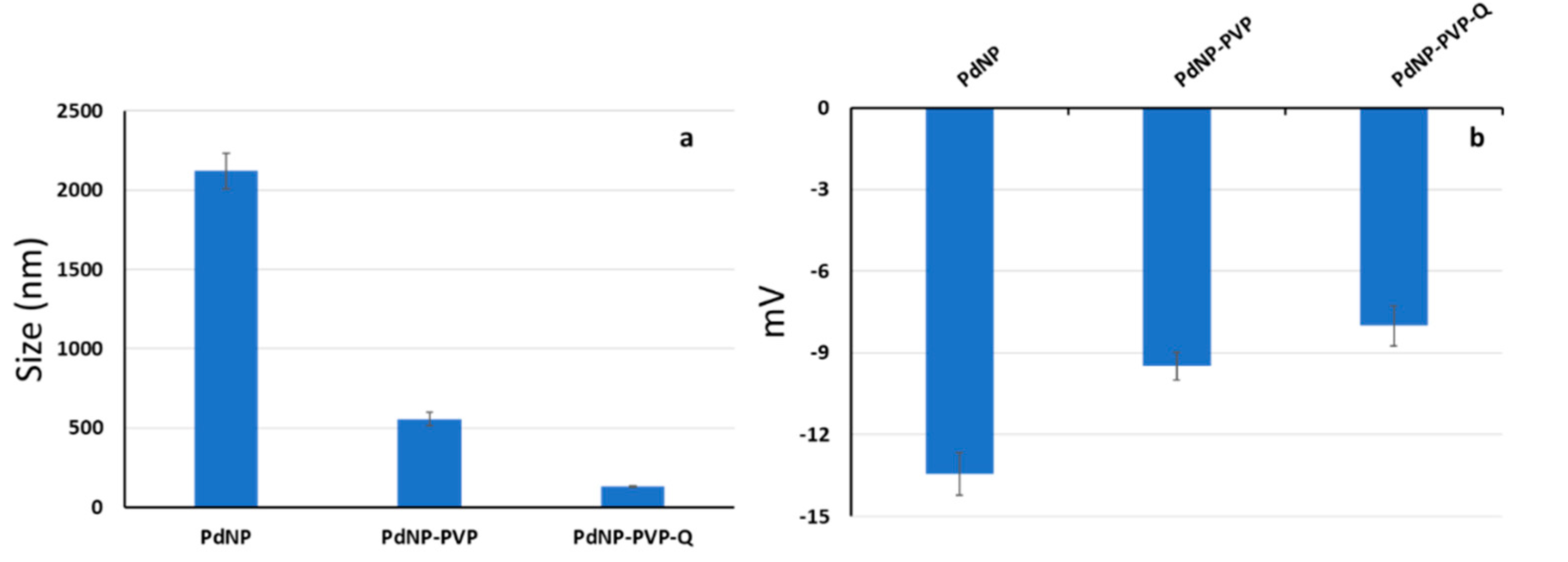
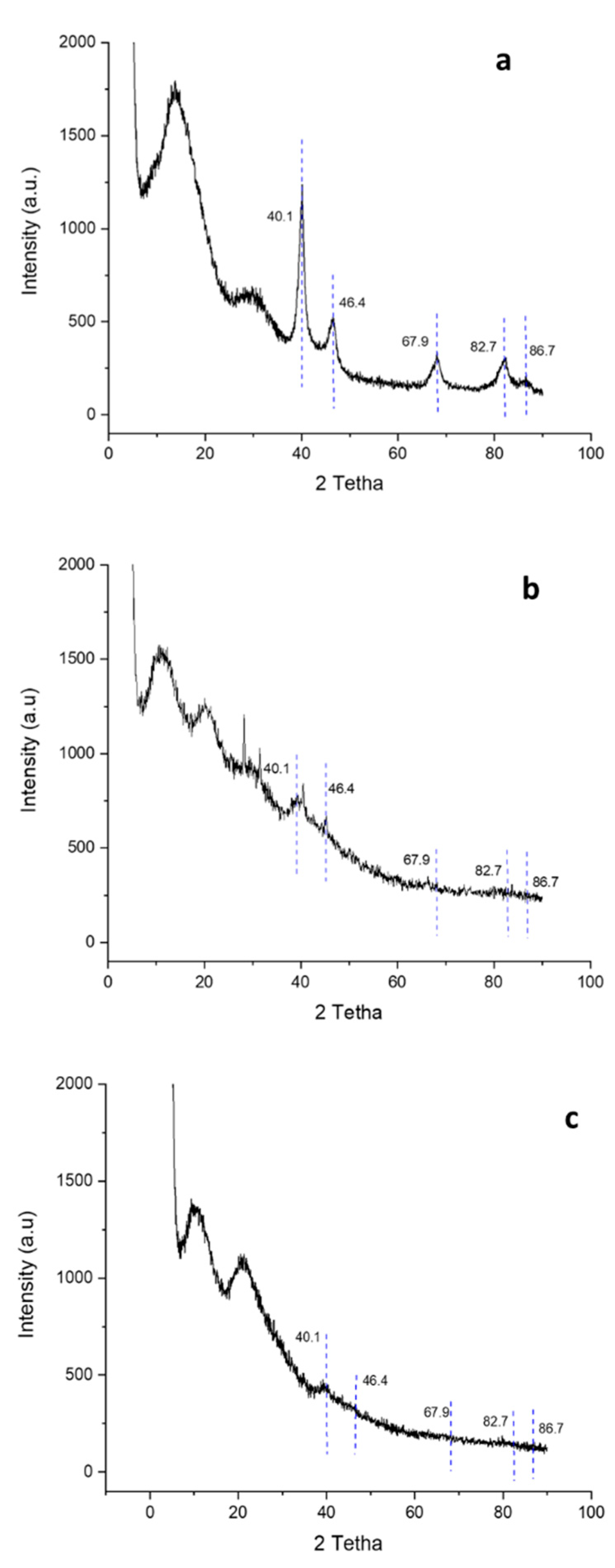
 Q,
Q,  PVP,
PVP,  PdNPs-PVP-Q.
PdNPs-PVP-Q.
 Q,
Q,  PVP,
PVP,  PdNPs-PVP-Q.
PdNPs-PVP-Q.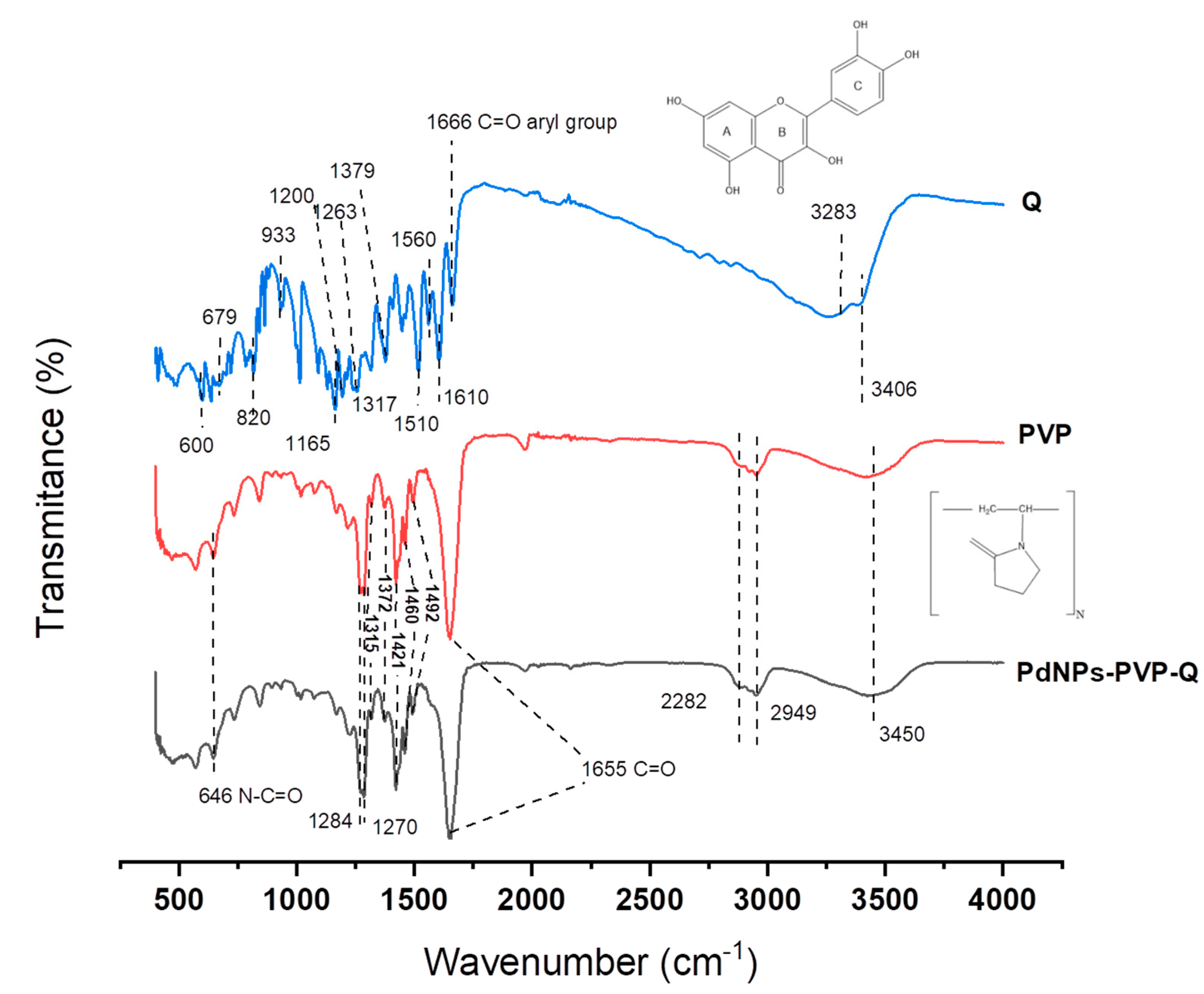
 quercetin,
quercetin,  PVP,
PVP,  PdNPs-PVP-Q,
PdNPs-PVP-Q,  dye.
dye.
 quercetin,
quercetin,  PVP,
PVP,  PdNPs-PVP-Q,
PdNPs-PVP-Q,  dye.
dye.
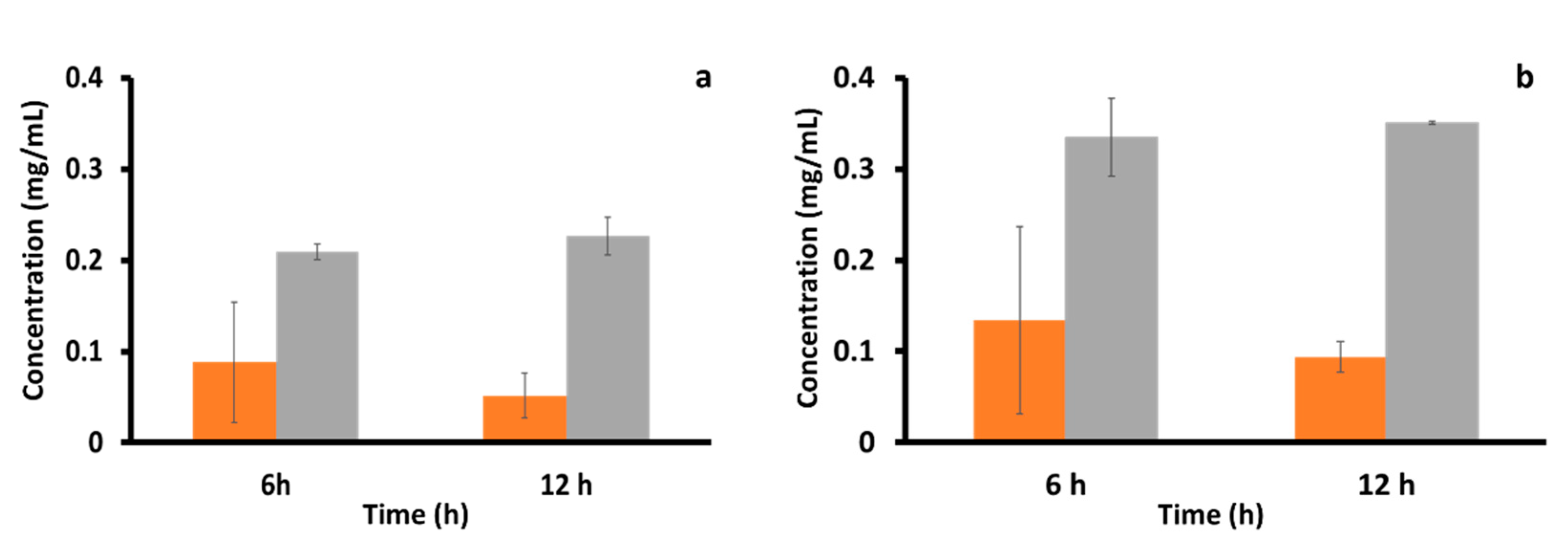
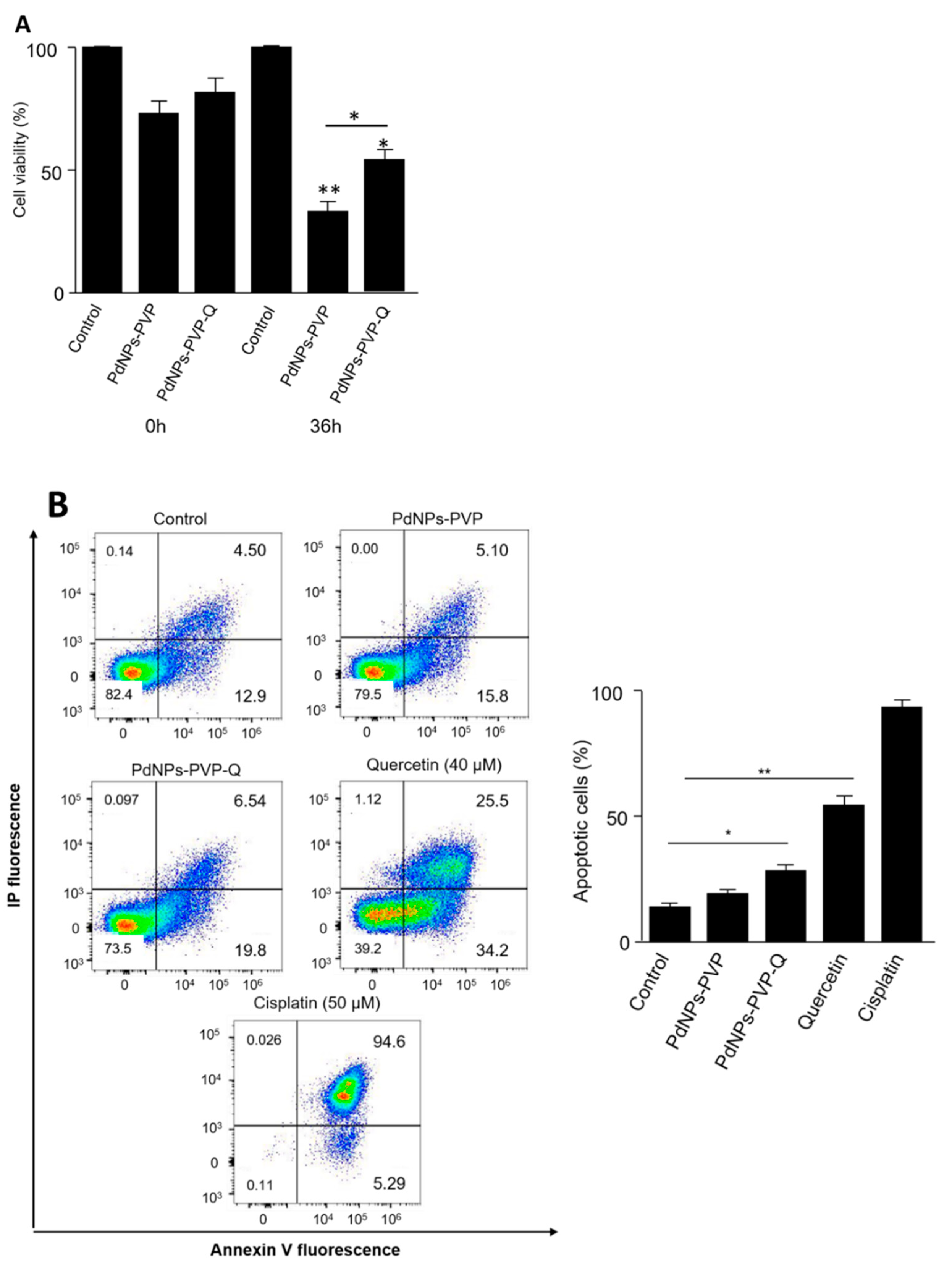
Publisher’s Note: MDPI stays neutral with regard to jurisdictional claims in published maps and institutional affiliations. |
© 2021 by the authors. Licensee MDPI, Basel, Switzerland. This article is an open access article distributed under the terms and conditions of the Creative Commons Attribution (CC BY) license (http://creativecommons.org/licenses/by/4.0/).
Share and Cite
Piñón-Castillo, H.A.; Martínez-Chamarro, R.; Reyes-Martínez, R.; Salinas-Vera, Y.M.; Manjarrez-Nevárez, L.A.; Muñoz-Castellanos, L.N.; López-Camarillo, C.; Orrantia-Borunda, E. Palladium Nanoparticles Functionalized with PVP-Quercetin Inhibits Cell Proliferation and Activates Apoptosis in Colorectal Cancer Cells. Appl. Sci. 2021, 11, 1988. https://doi.org/10.3390/app11051988
Piñón-Castillo HA, Martínez-Chamarro R, Reyes-Martínez R, Salinas-Vera YM, Manjarrez-Nevárez LA, Muñoz-Castellanos LN, López-Camarillo C, Orrantia-Borunda E. Palladium Nanoparticles Functionalized with PVP-Quercetin Inhibits Cell Proliferation and Activates Apoptosis in Colorectal Cancer Cells. Applied Sciences. 2021; 11(5):1988. https://doi.org/10.3390/app11051988
Chicago/Turabian StylePiñón-Castillo, Hilda Amelia, Rigoberto Martínez-Chamarro, Reyna Reyes-Martínez, Yarely M. Salinas-Vera, Laura A. Manjarrez-Nevárez, Laila Nayzzel Muñoz-Castellanos, César López-Camarillo, and Erasmo Orrantia-Borunda. 2021. "Palladium Nanoparticles Functionalized with PVP-Quercetin Inhibits Cell Proliferation and Activates Apoptosis in Colorectal Cancer Cells" Applied Sciences 11, no. 5: 1988. https://doi.org/10.3390/app11051988
APA StylePiñón-Castillo, H. A., Martínez-Chamarro, R., Reyes-Martínez, R., Salinas-Vera, Y. M., Manjarrez-Nevárez, L. A., Muñoz-Castellanos, L. N., López-Camarillo, C., & Orrantia-Borunda, E. (2021). Palladium Nanoparticles Functionalized with PVP-Quercetin Inhibits Cell Proliferation and Activates Apoptosis in Colorectal Cancer Cells. Applied Sciences, 11(5), 1988. https://doi.org/10.3390/app11051988








